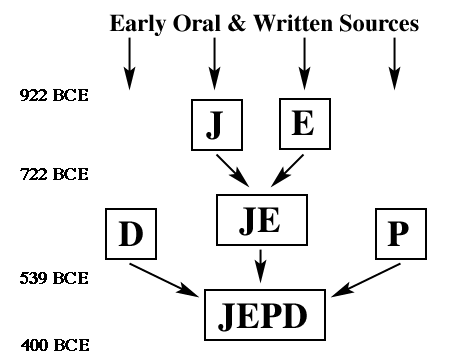Vocab:
Pentateuch - 1st five books of the Hebrew
Bible- (used interchangeable with Torah)
Torah -1st five books of the Hebrew Bible- (used interchangeable with
Pentateuch )
Literary analysis shows that the Pentateuch was not written by one person. Multiple strands of oral and written tradition were woven together to produce the Torah.
JEDP Source TheoryThe view that is persuasive to most of the critical scholars of the Pentateuch is called the Documentary Hypothesis, or the Graf-Wellhausen Hypothesis, after the names of the 19th-century scholars who put it in its classic form.
It is also called the JEDP Source Theory, and since that is the most straight-forward name, that is the name we will be using in this class.
Briefly stated, the JEDP Source Theory states that the Hebrew Bible (Christian Old testament) was written by a series of authors writing within 4 literary traditions. These traditions are known as J, E, D, and P.
J (the Jahwist or Jerusalem source) uses YHWH as God's name. This source's interests indicate the writer most likely lived in the southern Kingdom of Judah in the time of the divided Kingdom. The J source is responsible for most of Genesis.
E (the Elohist or Ephraimitic source) uses Elohim ("God") for the divine name until Exodus 3-6, where YHWH is revealed to Moses and to Israel. This source seems to have lived in the northern Kingdom of Israel during the divided Kingdom. E wrote Genesis 22 (the sacrifice of Isaac) story and other parts of Genesis, and much of Exodus and Numbers.
J and E were joined fairly early, apparently after the fall of the Northern Kingdom in 722 BCE. It is often difficult to separate J and E stories that have merged.
D (the Deuteronomist) wrote almost all of Deuteronomy (and probably also Joshua, Judges, Samuel, and Kings). This source would have lived in the southern Kingdom of Judah because the northern kingdom had been overrun and conquered by the Assyrians. Scholars often associate Deuteronomy with the book found by King Josiah in 622 BCE (see 2 Kings 22), but they believe that the time frame of the actual writing of the D material was written as early as Hezekiah's reform.
P (the Priestly source) provided the first chapter of Genesis; the book of Leviticus; and other sections with genealogical information, the priesthood, and worship. For a time frame for these writings, scholars view P as containing materials written prior to the Babylonian exile and during the exile, as well as having some materials written after the exile. Therefore, this source would have lived in the southern Kingdom of Judah, in Babylon, and in Jerusalem after the Babylonian exile.
We can diagram the relationship of the four sources as follows.

Contemporary scholars agree that the general approach of the JEDP Source Theory best explains the doublets, contradictions, differences in terminology and theology, and the geographical and historical interests that we find in various parts of the Torah.
Here are some differences between the four strands of tradition.
J
JahwistE
ElohistP
PriestlyD
Deuteronomistemphasizes the importance of the southern
Kingdom of Judahemphasizes the importance of the northern
Kingdom of Israelemphasizes the importance of the southern
Kingdom of Judah
emphasizes the importance of the central shrine which is the Temple in the city of Jerusalem, located in what had been the northern
Kingdom of Israel
stresses the importance of leadership in determining the fate of the Jewish people stresses the importance of prophets and prophetic statements stresses the importance of proper worship and the following of rituals and religious laws stresses the importance of fidelity to Jerusalem and to the central shrine in the Temple
speeches about God give God human qualities
refined speech about God majestic speech about God speech recalling God's work
God walks and talks with usGod speaks in dreams Worship driven approach to God moralistic approach
God is YHWHGod is Elohim (till Ex 3) God is Elohim (till Ex 3) God is YHWH
uses "Sinai"
Sinai is "Horeb" has genealogies and lists has long sermons
Sources
- Friedman, "Torah (Pentateuch)" in the Anchor Bible Dictionary.
- W. Gunther Plaut, ed., The Torah: A Modern Commentary (New York: Union of American Hebrew Congregations, 1981).
- Lawrence Boadt, Reading the Old Testament: An Introduction (New York: Paulist Press, 1984).
For further study:
Achtemeier, Paul J. ed. HarperCollins Bible Dictionary. San Francisco: Harper Collins Publishers, 1996. ISBN: 0060600373. See especially the article "Sources of the Pentateuch." [Energion.com Detail Page] [See my more detailed review of this book].
Metzger, Bruce M. ed. The New Oxford Annotated Bible with the Apocryphal/Deuterocanonical Books. New York: Oxford University Press, 1994. ISBN: 0195283562. [Energion.com Detail Page] [See my extended list of NRSV Bibles] See in particularly the introduction to the Pentateuch (XXXV and XXXVI) and the notes on the flood story in Genesis 6-9.
Suggs, M. Jack ed. The Oxford Study Bible, Revised English Bible with the Apocrypha. New York: Oxford University Press, 1992. ISBN: 0195290003. [Energion.com Detail Page] [See my extended list of REB Bibles and a review of this one] See in particularly the introduction to the Pentateuch (pp. 7-9), the notes on the flood story in Genesis 6-9 and the introductory article "Literature of the Ancient Near East" pp. 57-67.
von Rad, Gerhard. Genesis, Revised Edition. Philadelphia: The Westminster Press, 1972. ISBN: 0664209572. [Energion.com Detail Page]
Alexander, David ed. Eerdman's Handbook to the Bible. Grand Rapids: William B. Eerdmans Publishing Company, 1973. ISBN: 0802806392 [Energion.com Detail Page]. See the notes on Genesis 6-9 and the introduction to the Pentateuch, pp. 122-126.
Copyright Ó 1998, 2006 Henry E. Neufeld
http://ccat.sas.upenn.edu/rs/2/Judaism/jepd.html and http://energion.com/rpp/flood.shtml are the sources for the above information